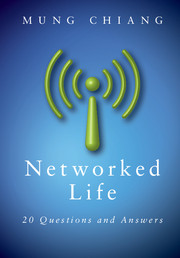Book contents
- Frontmatter
- Contents
- Preface
- Acknowledgements
- Roadmap
- 1 What makes CDMA work for my smartphone?
- 2 How does Google sell ad spaces?
- 3 How does Google rank webpages?
- 4 How does Netflix recommend movies?
- 5 When can I trust an average rating on Amazon?
- 6 Why does Wikipedia even work?
- 7 How do I viralize a YouTube video and tip a Groupon deal?
- 8 How do I influence people on Facebook and Twitter?
- 9 Can I really reach anyone in six steps?
- 10 Does the Internet have an Achilles' heel?
- 11 Why do AT&T and Verizon Wireless charge me $10 a GB?
- 12 How can I pay less for each GB?
- 13 How does traffic get through the Internet?
- 14 Why doesn't the Internet collapse under congestion?
- 15 How can Skype and Bit Torrent be free?
- 16 What's inside the cloud of iCloud?
- 17 IPTV and Netflix: How can the Internet support video?
- 18 Why is WiFi faster at home than at a hotspot?
- 19 Why am I getting only a few % of the advertised 4G speed?
- 20 Is it fair that my neighbor's iPad downloads faster?
- Index
- Notes
15 - How can Skype and Bit Torrent be free?
Published online by Cambridge University Press: 05 November 2012
- Frontmatter
- Contents
- Preface
- Acknowledgements
- Roadmap
- 1 What makes CDMA work for my smartphone?
- 2 How does Google sell ad spaces?
- 3 How does Google rank webpages?
- 4 How does Netflix recommend movies?
- 5 When can I trust an average rating on Amazon?
- 6 Why does Wikipedia even work?
- 7 How do I viralize a YouTube video and tip a Groupon deal?
- 8 How do I influence people on Facebook and Twitter?
- 9 Can I really reach anyone in six steps?
- 10 Does the Internet have an Achilles' heel?
- 11 Why do AT&T and Verizon Wireless charge me $10 a GB?
- 12 How can I pay less for each GB?
- 13 How does traffic get through the Internet?
- 14 Why doesn't the Internet collapse under congestion?
- 15 How can Skype and Bit Torrent be free?
- 16 What's inside the cloud of iCloud?
- 17 IPTV and Netflix: How can the Internet support video?
- 18 Why is WiFi faster at home than at a hotspot?
- 19 Why am I getting only a few % of the advertised 4G speed?
- 20 Is it fair that my neighbor's iPad downloads faster?
- Index
- Notes
Summary
We just went through some of the key concepts behind the TCP/IP thin waist of the Internet protocol stack. We will now go through five more chapters on technology networks, focusing on two major trends: massive amounts of content distribution and the prevalent adoption of mobile wireless technologies.
Scaling up the distribution of content, including video content, can be carried out either through the help of peers or by using large data centers. These two approaches, P2P and cloud, are described in this chapter and the next, respectively. In particular, P2P illustrates a key principle behind the success of the Internet: under-specify protocols governing the operation of a network so that an overlay network can be readily built on top of it for future applications unforeseen by today's experts. It also illustrates the importance of backward compatibility, incremental deployability, and incentive alignment in the evolution of the Internet.
A Short Answer
Skype allows phone calls between IP-based devices (like laptops, tablets, and smartphones) or between IP devices and normal phones. It is free for IP-to-IP calls. How could that be? Part of the answer is that it uses a peer-to-peer (P2P) protocol riding on top of IP networks.
P2P started becoming popular around 1999. For example, Kazaa and Gnutella were widely used P2P file- and music-sharing systems back then. However, incentives were not properly designed in those first-generation P2P systems; there were a lot of free riders who did not contribute nearly as much as they consumed.
- Type
- Chapter
- Information
- Networked Life20 Questions and Answers, pp. 334 - 357Publisher: Cambridge University PressPrint publication year: 2012



